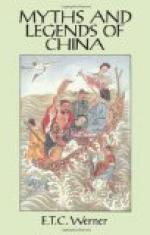Ecclesiastical Institutions
The dancing and chanting exorcists called wu were the first Chinese priests, with temples containing gods worshipped and sacrificed to, but there was no special sacerdotal class. Worship of Heaven could only be performed by the king or emperor. Ecclesiastical and political functions were not completely separated. The king was pontifex maximus, the nobles, statesmen, and civil and military officers acted as priests, the ranks being similar to those of the political hierarchy. Worship took place in the ‘Hall of Light,’ which was also a palace and audience and council chamber. Sacrifices were offered to Heaven, the hills and rivers, ancestors, and all the spirits. Dancing held a conspicuous place in worship. Idols are spoken of in the earliest times.
Of course, each religion, as it formed itself out of the original ancestor-worship, had its own sacred places, functionaries, observances, ceremonial. Thus, at the State worship of Heaven, Nature, etc., there were the ‘Great,’ ‘Medium,’ and ‘Inferior’ sacrifices, consisting of animals, silk, grain, jade, etc. Panegyrics were sung, and robes of appropriate colour worn. In spring, summer, autumn, and winter there were the seasonal sacrifices at the appropriate altars. Taoism and Buddhism had their temples, monasteries, priests, sacrifices, and ritual; and there were village and wayside temples and shrines to ancestors, the gods of thunder, rain, wind, grain, agriculture, and many others. Now encouraged, now tolerated, now persecuted, the ecclesiastical personnel and structure of Taoism and Buddhism survived into modern times, when we find complete schemes of ecclesiastical gradations of rank and authority grafted upon these two priestly hierarchies, and their temples, priests,




